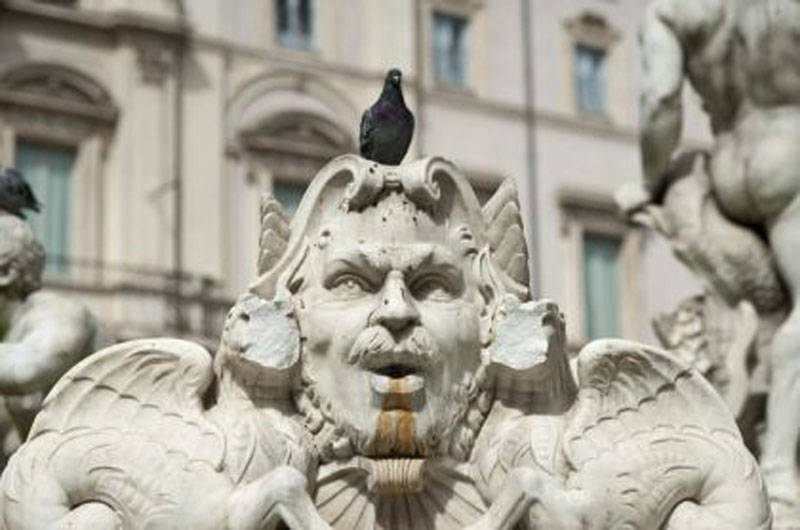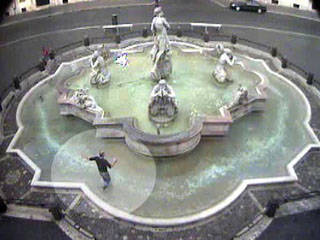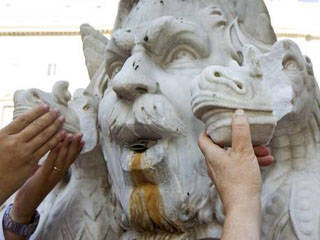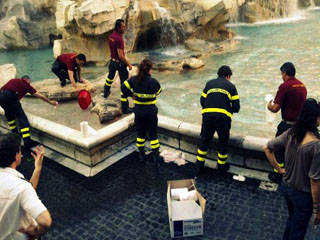The Vandals are Back in Rome, but Who are They?
The Vandals sacked Rome back in 455. Today their equivalent have returned, striking this weekend to add a few cracks to the city’s art heritage, and to its legendary promise to remain the beloved Eternal City. Visited annually by some 23 million visitors, Piazza Navona is perhaps Rome’s most beloved square after St. Peter’s. At 8:30 Saturday morning, while its cafes were serving cappuccini and corneti, a man of perhaps 45 years of age jumped into the Baroque-era Fountain of the Moor, one of the two side fountains in Piazza Navona. Cameras show that he first tried to strike at the central figure, but slipped and instead smashed at one of the marble masks that decorate the fountain border.
The Fountain of the Moor, the work of Giacomo della Porta, dates from 1575 and hence predates Bernini’s central Fountain of the Four Rivers. Its central statue is a Neptune-like figure with an African look (hence the word “Moor” or Moroccan in the name) standing in a conch shell and wrestling with a dolphin, surrounded by four statues of Tritons, or demi-gods of the sea. “The vandalism was the work of the usual idiots,” said Rome’s Cultural Heritage councilman Umberto Broccoli, “but fortunately police intervened quickly, and all the broken fragments were recovered.” Fortunately, too, this is a 19th century copy; the real thing is kept elsewhere.
Fine—but later in the day another of the usual idiots (or perhaps the same) threw a few heavy paving stones of basalt (sanpietrini) at the Trevi Fountain sculptures, which had been restored fairly recently at considerable expense. Much of the Trevi Fountain is made of the fairly fragile Roman marble, travertine, which splinters easily. There too telecameras—and there are 1,200 scattered around downtown historical Rome—were in action, and witnesses saw the man act so hopes are high that he will be identified and arrested.
Late Saturday night, in addition, a 20-year-old American tourist was hauled into the police station near the Colosseum after he was caught scaling the wall of the Colosseum and trying to pry off pieces of travertine to take home as a souvenir. At least in this case he has been identified, but otherwise throwing stones at precious monuments is all too easy, and casual vandalism is a problem that is creeping up on all of us who live here and love the beauty of the city.
Vincenzo Maruccio, the Lazio regional secretary for Antonio Di Pietro’s Italia dei Valori political party, blames the men and women at the top. “A leadership class that privatizes the Colosseum and organizes private events in place the whole world envies us for does not set a good example. Rome is ever less safe, It’s being turned over to hoodlums and delinquents, while the big crime organizations work undisturbed.” The reference to privatization is the awarding of the rights to the Colosseum image for publicity to shoe tycoon Diego Della Valle.
“There is a total lack of respect for the art heritage of the city of Rome,” Maruccio went on to say.
Neighborhood residents complain that petty crime, excess noise and vandalism is all too common in and around Piazza Navona, which—importantly—has elements from the square’s original ancient Roman substructure and is next door to an important museum. “This is no man’s land,” one Piazza Navona storekeeper protested. “Lots of people still jump into the fountains for fun.” Fun? Well, in 1997 a youth jumped into the Bernini fountain, using the tail of one of its marble sea monsters for his diving board. The tail broke off. There can be little justification in the evident lack of police supervision or failure to identify the graffiti writers who leave hideous smears on freshly painted walls in Rome. One friend of mine, who lives near Campo de’ Fiori, repaints her front door weekly.
Other monuments in Italy are at risk. The obelisk at Piazza del Popolo, which came to Rome in 10 AD, has been covered with graffiti. The statues of national Italian heroes on the Janiculum Hill have been losing their heads for years. Even the stairs of the Spanish Steps show damage. A British School marble balustrade was damaged, repaired, and damaged again, three times in all. A year ago in Parma the wall of the cathedral, the Duomo, was damaged by graffiti writers. In Genoa the monumental cemetery, which is considered the equivalent of an open-air museum for its fine statuary, has been systematically damaged. At Pompeii the House of the Chaste Lovers was sacked by thieves in 2003. And at Trani in Southern Italy two medieval stone lions at the entrance to the cathedral were damaged.
On this same weekend in the little town of Trevignano Romano where I live, an hour north of Rome, population 6,000 or so, vandals struck, knocking down and obliterating the occasional historical markers that appear every few hundred yards along a lovely lakeside walkway. The week before unruly youths literally knocked down the front door of the home of a woman living alone. Is there a connection with the vandalism in Rome? Possibly.
Maruccio’s explanation is that resentment of social injustice is combined with the knowledge that the vandals will not be punished. In fact, the image of the man who took a hammer to the Fontana del Moro was caught on more than one camera, but is fuzzy enough that his capture seems unlikely. To this I would add that the abuse of alcohol and drugs is demonstrably on the rise among young Italians, including the 15-year-olds. Among young Europeans between 15 and 29 years of age one death out of four is a result of abuse of alcohol. This is a new problem for Italy. In addition, the relatively low cost of cocaine today has made it by far the most popular drug in Italy, estimated at representing 80% of all illegal drug sales.





































i-Italy
Facebook
Google+
This work may not be reproduced, in whole or in part, without prior written permission.
Questo lavoro non può essere riprodotto, in tutto o in parte, senza permesso scritto.